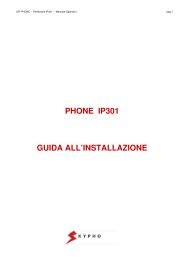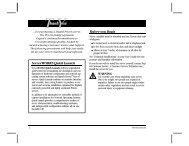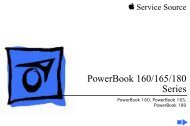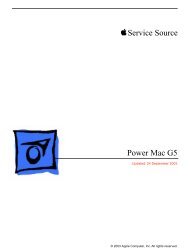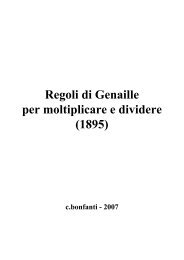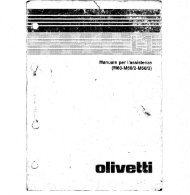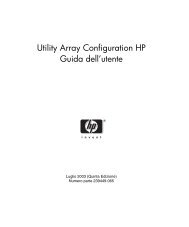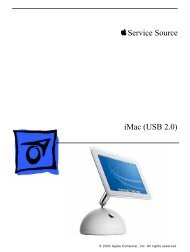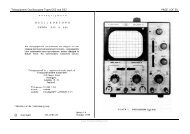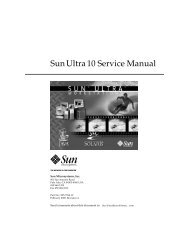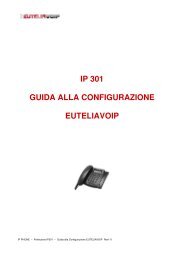HPJournal1989Jun_798.. - Dynamic Softer for Background-Images
HPJournal1989Jun_798.. - Dynamic Softer for Background-Images
HPJournal1989Jun_798.. - Dynamic Softer for Background-Images
Create successful ePaper yourself
Turn your PDF publications into a flip-book with our unique Google optimized e-Paper software.
host command to space to a record or file, all super-blocks<br />
must be read and processed to determine the location of<br />
the next record or file. This is not a problem when the tape<br />
is moving <strong>for</strong>ward, since no per<strong>for</strong>mance penalty is incurred<br />
by reading the data instead of spacing over it. However,<br />
since the HP 7980 family of drives cannot read data when<br />
the tape is moving in reverse, reverse record/file spacing<br />
becomes much more complicated. Super-blocks on the tape<br />
must first be backed over and then read in the <strong>for</strong>ward<br />
direction. Hypothetically, if a backspace file command<br />
were issued near the end of the tape and the beginning of<br />
the preceding file was very near the beginning of the tape,<br />
all of the super-blocks on the tape would have to be backed<br />
over and then read, a situation that might be intolerable.<br />
The backspace file problem is solved by recording in<br />
each super-block the running count of how many superblocks<br />
have been written since the last file mark was written.<br />
This provides the in<strong>for</strong>mation needed to determine<br />
how many records can be safely backed over without missing<br />
the file mark. Thus, single backspace file commands<br />
can be executed efficiently. The backspace record command<br />
does not negatively impact per<strong>for</strong>mance because the<br />
previous record is typically within the current super-block<br />
or the preceding one.<br />
Another issue that had to be addressed was overwriting.<br />
This occurs when a host writes and fills the entire tape,<br />
rewinds the tape, and then writes a directory at the beginning<br />
of the tape, expecting the rest of the previous writes<br />
to remain intact. This practice is strongly discouraged <strong>for</strong><br />
sequential access devices, but does occur. If it is done, it<br />
invalidates the backspace file in<strong>for</strong>mation in some of the<br />
super-blocks. This is because extra records and/or file<br />
marks are put back onto the tape after the previous backspace<br />
file in<strong>for</strong>mation was written.<br />
To support this activity, a physical tape mark is written<br />
to the tape whenever the host switches from writes to any<br />
other tape motion command. If a tape mark is encountered<br />
during backspacing, it indicates that some data has been<br />
previously overwritten. The backspace operation must read<br />
the super-block in front of the tape mark because the previous<br />
in<strong>for</strong>mation used in the backspace file command may<br />
have been corrupted by an overwrite condition. By reading<br />
2.8<br />
E ,.5<br />
I<br />
'I 2.4<br />
o<br />
E r.z<br />
a 2.0<br />
P 1.8<br />
I<br />
3 t.o<br />
o<br />
i. to<br />
@ 1.2<br />
this super-block, the tape drive gets accurate in<strong>for</strong>mation<br />
regarding the start of the file.<br />
Results<br />
The true figure of merit <strong>for</strong> the HP 79B0XC in compression<br />
mode is the observed tape compaction ratio. This ratio<br />
combines the benefits of the HP data compression algorithm<br />
with the advantages of super-blocking. The tape<br />
compaction ratio is equal to the compression ratio of the<br />
host data times the super-blocking advantage factor (SAF).<br />
The SAF is dependent upon the average host data record<br />
size. A graph of SAF versus average record size is shown<br />
in Fig. 4. The compression ratio is a function of the amount<br />
of redundancy exhibited by the host's data.<br />
The following table shows the data compression benchmark<br />
results previously outlined on page 31 with the overall<br />
tape compaction results obtained with an HP 79B0XC<br />
Tape Drive.<br />
Summary of HP 7980XG Tape Compaction Results<br />
Data Description Volume Compression Tape<br />
(Mbytes) Ratio (alone) Compaction<br />
MPE/MPE XL on HP 3000s<br />
Series 68 (HP Desk) 528<br />
Series 68 (Data Basel 2924<br />
Series 68 (Misc. Data) 1559<br />
Series 70<br />
IManufacturing)<br />
Series 930 (Code)<br />
2524<br />
311<br />
aoe<br />
4.31<br />
4.30<br />
4.31<br />
3.44<br />
4.35<br />
4.83<br />
5.04<br />
483<br />
3.97<br />
HP-UX on HP 9000s<br />
Series 800 226 2.06 2.73<br />
(Commercial HP-UXl<br />
Series 500 (CodeJ 363 2.38<br />
z.a /<br />
Series 500 (DataBase) 336 4.O7 4.39<br />
Series 500 (VLSII 785 2.52 3.34<br />
Series 300 (Archive) 325 2.30 3.05<br />
DEC<br />
DECVAX (Code)<br />
HP Series 200 Running<br />
Pascal O.S.<br />
Series 200 (Misc. Datal 467<br />
Amdahl<br />
Amdahl (Corporate Datal 5000<br />
423 2.31<br />
J./Y<br />
2.65<br />
2.67<br />
3.86<br />
1.0<br />
't 2 4 5 810 20 40 60<br />
Average Host Data Record Size (K Bytes)<br />
Fig. 4. Super-blocking advantage factor (SAF) versus data<br />
record size <strong>for</strong> atape written at6250 bpiwith 0.3-inch gaps<br />
34 HEWLETT.pAcKARD JoURNAL JUNE 1989




